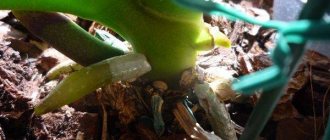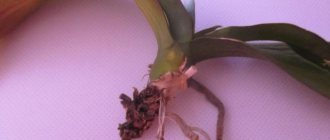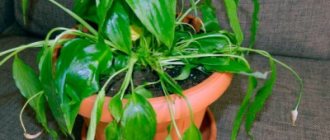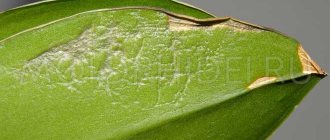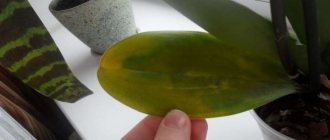Orchids are epiphytic plants that live in nature on the trunks and branches of trees. Their roots absorb water from the air, and mineral elements come from rotted plant remains.
If indoor conditions are far from natural, the orchid begins to have problems with its roots .
The pathogenic process proceeds slowly , therefore, if diseased roots can be identified, the orchid can be saved. In this article you will learn what to do if the orchid roots turn yellow.
Yellow roots of an orchid are a consequence of uncomfortable maintenance of the plant
This can happen in a number of cases:
- the plant was planted too deep in the substrate;
- put the pot in a dark place;
- uncomfortable conditions for keeping the flower .
Important. Leaf damage occurs especially quickly when abundant watering is combined with low air temperature in the place where the orchid is kept.
To avoid diseases of the root system, the orchid should be planted in a transparent container filled with a hygroscopic substrate.
Age
Old leaves may turn yellow and fall off
Leaves may turn yellow and fall off due to old age, but in their place, new, young, light green leaves will certainly grow. Usually the process begins with the lowest leaves, gradually rising up the trunk of the flower. There are also phalaenopsis hybrids that necessarily shed their foliage during flowering.
Why do the roots turn yellow?
The reasons that cause the appearance of yellowed roots can be different:
- soil quality . A dense or poor-quality substrate prevents air circulation and creates conditions for oxygen starvation of the roots. It also promotes the development of pathogens;
- improper watering . Excessive watering or too frequent moistening leads to stagnation of water and rotting of the roots;
- lighting. An orchid needs a lot of diffused light, so in the autumn-winter period it is better to illuminate the plant with a phytolamp. A lack of light reduces the orchid's immunity, making it more susceptible to diseases, including fungal infections.
- Pot size is too large. A large pot volume increases the likelihood of water stagnation; in this case, it is difficult to correctly assess the degree of drying of the substrate.
If rotting of the roots of the system is not detected in time, this can lead to the death of the plant .
How dangerous is color change?
Roots are an important organ of plants, in particular orchids . They nourish the plant with liquid, minerals, and participate in photosynthesis and gas exchange. These processes are vital for the flower, and if the organs are sick, then the general condition noticeably worsens.
As you know, orchids have aerial and internal roots. Yellowing of certain rhizomes is a signal that the plant is not healthy. You should immediately understand the causes and begin treatment. Otherwise, the roots will turn yellow and dry out, and the flower itself will die. And resuscitation of an orchid without roots is possible, but the process is long and not always successful. Therefore, it is better not to let this happen, because problems with the roots are fraught with serious consequences.
What to do if the roots turn yellow but are elastic?
The reasons for the appearance of yellowness at the roots are different, and further actions that need to be taken depend on this.
First aid
If the yellow roots of the orchid have retained their elasticity and are hard to the touch, this is a sign of their vitality. In this case, the roots are not cut; it is enough to adjust the care and rules for maintaining the flower:
- the root system is carefully inspected so as not to miss a rotten area;
- if the roots or a section of the root are pressed through when pressed with a fingernail, the root is cut off to healthy tissue.
A timely diagnosis will allow you to save the plant.
How to care for it to preserve it?
When revived by any method, the plants are provided with ideal environmental conditions: twelve-hour daylight hours, diffused lighting and an air temperature of 20-27 degrees. During the period of root system restoration:
- Reduce the amount of nitrogen in fertilizing.
- If the flower lacks moisture and the leaves lose turgor, they are sprayed.
- Provide regular but meager watering.
In a favorable environment, the orchid will begin to grow roots almost immediately after transplantation. Small flowers will restore the root system in 2-3 months, large specimens will need about six months. Until the plant's health is restored, it will not grow or bloom.
The roots are yellow and soft - a sign of rotting. How to treat?
Yellow plaque can be caused by bacterial or fungal rot; such a plant needs urgent treatment .
Fungal diseases of the root system are often accompanied by the formation of yellow mold on the roots , the appearance of yellow balls (mycelium plexus) and plaque. If these signs are detected, as well as in the case of bacterial infections of the roots:
- the orchid is removed from the soil , the roots are washed with warm water;
- use a disinfected instrument to remove all unhealthy roots ;
- the sections are rubbed with crushed activated carbon;
- if affected by fungi, the root system is soaked in a solution of 0.2% Fundazol solution for 15 minutes;
- if the roots are affected by bacterial rot, they are treated with copper-based bactericidal preparations - copper hydroxide (CuOH), copper peroxide (CuO2) or Bordeaux mixture.
Crystalline copper acts as a mechanical barrier, preventing the spread of disease along the root surface.
Attention. Treatment of the roots can be carried out by immersing the pot in water with a dissolved preparation.
To consolidate the positive effect, the procedure is carried out three times with an interval of 10-14 days . Then the plant is transplanted into a new substrate and a new pot and optimal conditions are created.
The healing power of water
Soak the roots of a diseased orchid in water daily. Place a vessel with water and an orchid on the window. The optimal air temperature for the procedure is 20 degrees Celsius. Every morning, pour water into the container with the flower so that it covers only the rhizome (rhizome) of the orchid. The orchid should “take baths” for one to two hours, but if you leave it in the water for a longer period, it’s also not scary.
To awaken dormant buds on an orchid, try treating it with baths with growth stimulants - for example, an aqueous solution of epin at the rate of one drop of the drug per liter of water. Don't overdo it with these baths! You can bathe an orchid in stimulants no more than once every two weeks.
How quickly does an orchid recover? It depends on your luck. For some, the orchid comes to life in a month, for others it will take a year, and for others it may not work out at all. But if the period of resuscitation occurred in spring or autumn days, then your chances of reviving the plant double.
Prevention measures
Optimal prevention of fungal and bacterial infections lies in following the rules for the care and maintenance of the orchid . When planting, you should use only high-quality soil, and:
- substrate particles should not be mixed , since smaller particles fill the gaps and reduce the size of the voids;
- The soil mixture should not be compacted too tightly.
Every two to three years the substrate is replaced with a new one . Compliance with all the rules will ensure the restoration of health and prosperity of the orchid.
Fertilizers
If a previously healthy home orchid has suddenly turned yellow and dried out, the cause may be an overabundance of fertilizers. When the stem and flowers wither and the leaf falls off, you can save the phalaenopsis. To do this, rinse the substrate or replant the flower; you cannot feed it for the next few months; after that, only with diluted fertilizer.
If only the tips or lower leaves turn yellow and wrinkled, then the orchid suffers from an excess of calcium. Change the substrate. In this case, for a while the need for feeding disappears. If the orchid turns yellow on top, veins appear on the leaves and fall off over time, then the reason is a lack of potassium - use a special fertilizer.
Stress
Orchids are delicate and capricious, sensitive to any changes. Changing lighting and temperature conditions, or moving to a new place are stressful. If the leaves turned yellow and fell off after the above changes, there is no need to guess why the flower dried up. The flower should get used to stressful situations gradually - move the pot to a new place for a couple of hours, then return it back.
The flower's homeland is the tropics, hence the love for humid environments. Dry air will cause leaves to turn yellow, dry at the tips and fall off. To revive it, provide the right level of humidity with a humidifier or frequent spraying, and the flower will quickly return to normal. If the soil is dry, rinse it under running water.
Major pests
The green above-ground parts of the plant are very tender, so they often become a tasty morsel for a variety of pests, which can also cause yellow leaves (Figure 5).
Among the common pests of indoor orchids are:
- The spider mite feeds on the sap of the plant, and the stems and leaves are covered with small dots (bite spots) and cobwebs. The diseased flower must be immediately isolated from the rest so that the pests do not spread, and all leaves of the affected specimen must be thoroughly washed with a solution of laundry soap.
- Aphids not only change the color of the leaf plate, but also cause the appearance of a sticky coating on its surface. To eliminate aphids, you need to wash the orchid with soapy water and spray it with Fitoverm.
- Scale is an insect that is difficult to eliminate, since its body is covered with a dense shield. The pest is easy to detect: when a scale insect infests the plant, characteristic growths appear on the surface of the plant. To combat the pest, you can use folk remedies, such as ammonia or a mixture of water and vegetable oil, but it is better to use special preparations for this purpose, for example, Actellik.
Figure 5. Main flower pests (from left to right): spider mites, aphids and scale insects
Features of the orchid root system
This crop has a root system that is different from all plants: most of it is above the ground. The rhizome of this wonderful flower consists of 3 parts:
- thin and strong underground process. It is firmly stuck in the ground and nourishes the plant with minerals and water extracted from the soil;
- a layer of dead hollow cells - velamen. This fabric serves the plant well during periods of drought or lack of watering. It absorbs water from the air and rain. Another task of velamen is to protect the root from damage and creases. When healthy, this layer is greenish, white or silvery in color;
- apex in growth. It is very fragile and easily damaged, leading to the death of the entire root.
Interesting! Orchids are epiphytes, i.e. Thanks to their root system, they are attached to other plants, but they obtain nutrients themselves.
What are aerial roots?
Aerial roots are root systems that live above the ground. Its main task is to obtain moisture from the air. Aerial roots appeared in orchids out of necessity. Its habitat is predominantly tropical forests, where fog is most common, as well as rocky areas. And as a result, the penetration of water from the soil becomes impossible. Therefore, the plant gained the ability to extract water from the air.
All aerial roots have velamen - a special layer that collects and condenses moisture, which nourishes the plant. The main functions of the above-ground root system:
- flower nutrition;
- additional support for a fragile plant;
- participation in photosynthesis (the formation of carbohydrates using light);
- a possible method of respiration in plants growing in marshy areas.
The aerial processes of the root system are usually thick and therefore seem highly durable and dense. They need special care.
Care instructions
If the care rules are followed, but the orchid still dries out, try the following tips:
- Alternate the method of watering - immerse in a large container of water, and next time water from above, avoiding the lower leaves and trunk.
- Spray the flower regularly with warm water.
- If the roots are bright green, there is enough moisture in the substrate, if they have lightened and become silvery, water them immediately, the soil is drying out.
- After flowering, do not cut the flower stalks at the root; if they have not dried out, leave them alone, and after a while, carefully trim the dry areas.
- Use special soil for orchids, it contains pieces of bark.
- Cover the earthen ball with moss, this will protect it from drying out and retain moisture inside the pot.
- An orchid is replanted only during the dormant period, until the bulb appears and the peduncle has dried up.
If the phalaenopsis does not bloom for a long time, place it in a dark room and later return it to its place. A contrast shower also helps a lot - warm water first, then cool water. Soon she will delight you with a young shooter.
